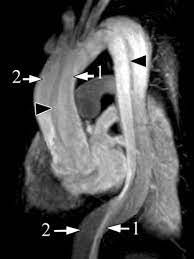An aortic dissection is where part of the tunica intima which is the endothelial or the innermost layer of the blood vessel of the aorta is ripped off.
What happens is a tear in the tunica intima of the aorta forms and the high-pressured blood flowing through the aorta begins to tunnel between the tunica intima in the tunica media separating the two layers, now as the high-pressured blood continues to shear more and more of the tunica intima of the tunica media blood starts to pull between the two layers increasing the outside diameter of the blood vessel the area where blood collects between the tunica intima and the media is called a false lumen and the true lumen is the regular lumen of the blood vessel since high pressure is a cause of aortic dissection.
It's no surprise that the aorta is
the prime target for this problem so what causes aortic dissections? Well, chronic hypertension is the major cause whether the hypertension is caused by
stress or from increased blood plasma volume like in pregnancy; blood vessel coarctation
which is the narrowing of a blood vessel can also cause dissection, aortic
dissections most often happen in the first 10 centimeters of the aorta closest
to the heart a tear near the heart or in the upper aorta is considered a Type A
aortic dissection in the Stanford classification system.
Type b aortic dissections involve tears in the lower aorta or descending aorta both type a and b aortic dissections can extend into the abdomen in order for aortic dissection to occur an underlying condition usually has to exist that weakens the aorta's wall connective tissue disorders like marfins in Ehlers-Danlos syndrome can cause a dissection as well as decrease blood flow to the vase of esorum, aneurysms can be a cause of aortic dissection as well an incidental dissection can also cause aneurysms because again the dissection weakens the blood vessel wall, in other words, weak walls can lead to an outpouching of the blood vessel or a break in the tunica intima and both of these weaken the walls.
Further aortic dissections cause a
whole bunch of other problems to a lot of complications is related to where
the blood in the false lumen flows the blood could flow back up the aorta to
the heart and enter the heart's pericardial space filling it with blood and
causing pericardial tamponade, a really bad and potentially fatal situation,
the blood flowing through the false lumen could also puncture a hole through
the tunica media and tunica externa and bleed into the mediastinum which would
kill you really fast because that's a lot of blood leaving the vascular system
very quickly the tunneling blood could also puncture a hole in the tunica
intima and return into the true lumen yet.
Another possibility is that the blood could continue to tunnel between the tunica intima and tunica media until it reaches another artery that branches off the aorta like the renal arteries or the subclavian arteries the blood and the false aluminum can put pressure on these branching arteries decreasing blood flow to the kidneys and arms causing a whole new mass to deal with the main symptoms of aortic dissection are sharp chest pains that often radiate to the back, a person might also develop weak pulses in downstream arteries like the brachial or femoral arteries or sometimes there may be differences in blood pressure between the left and right arm.
An aortic dissection is an emergency because it can lead to hypotension or low blood pressure as well as a shock if there's a rupture and significant blood loss on a chest x-ray there's typically a widened aorta more sensitive imaging techniques that are commonly used include a trans-esophageal echocardiogram which is where an ultrasound probe is passed through the esophagus to obtain a clear picture of the aorta there's also ct angiography and magnetic resonance angiography both of which look closely at the blood vessels. An aortic dissection needs to be treated immediately type A aortic dissections are treated surgically where a surgeon takes out as much of the dissected aorta as possible and blocks the entry of blood into the wall of the aorta the aortic wall is then reconstructed with synthetic graft and sometimes that graft is propped open with a wire mesh stent. Type B aortic dissections are treated with beta blockers and nitroprusside.
All right as a quick recap, aortic
dissection is where blood tunnels between the tunica intima and tunica media
separating the two layers and creating a false lumen, this is a rare condition
that most often happens with a history of high blood pressure connective tissue
disorders and aneurysms, an aortic dissection can lead to emergency situations
like cardiac tamponade and shock and should be treated immediately.
Thank You








